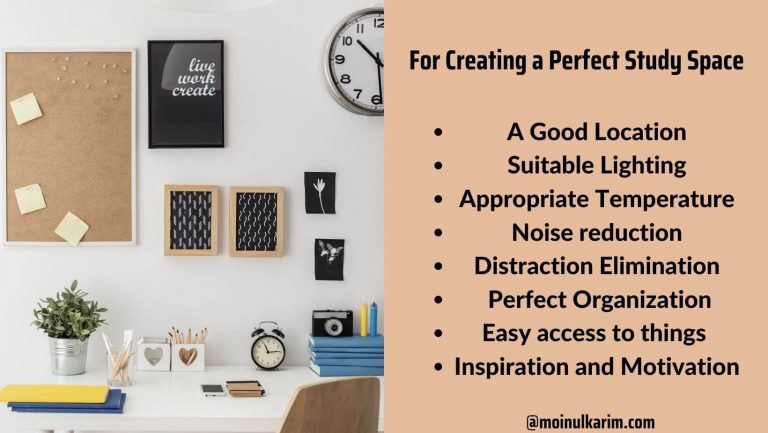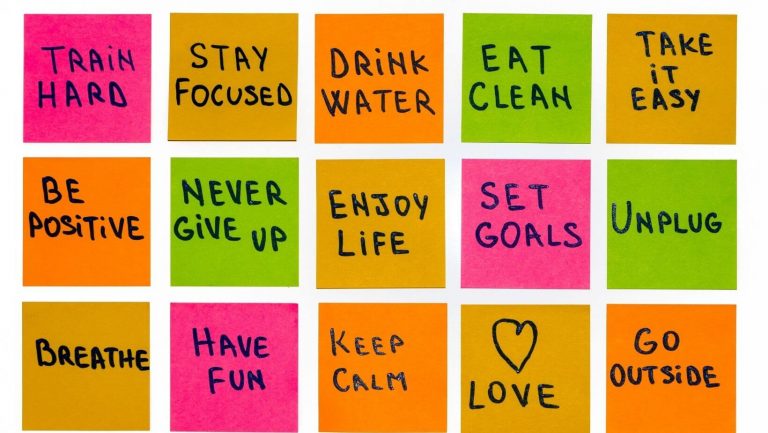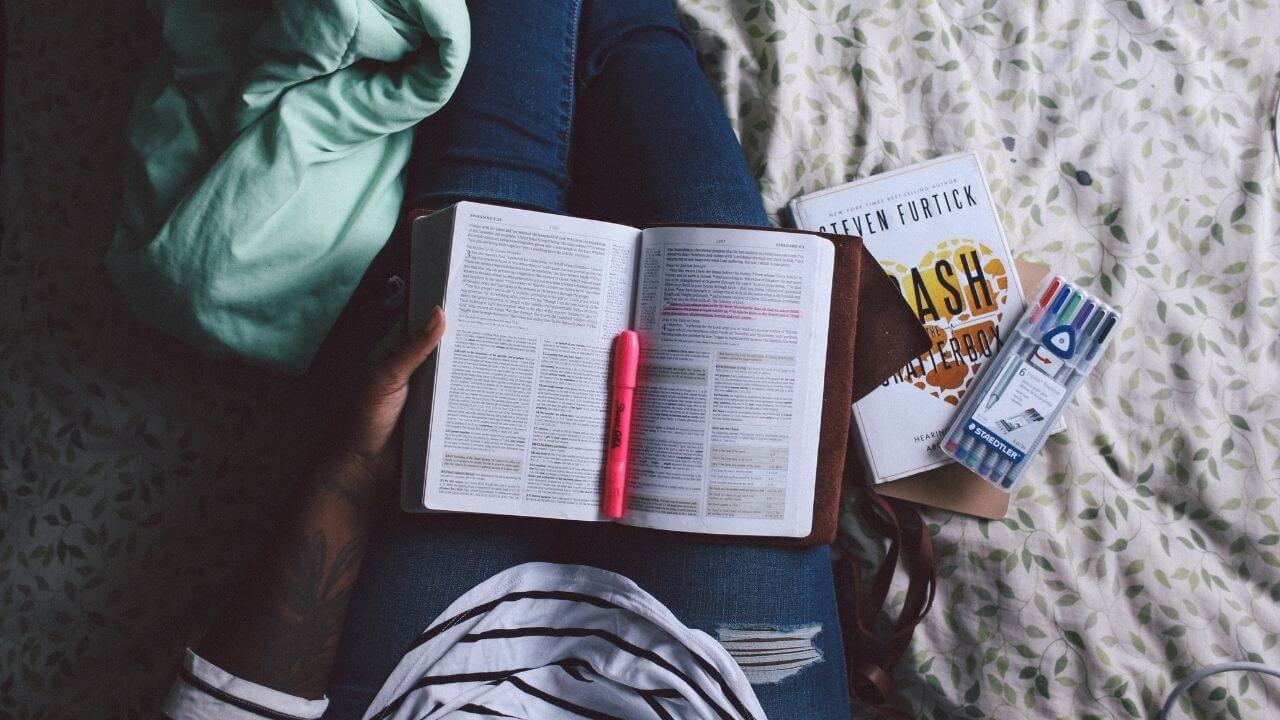Introduction
Studying at home can be overwhelming and distracting, considering all the interruptions we face at our homes. Students fail to get the most out of their study sessions due to a lack of a perfect study environment at home. A study environment should be simple yet effective. One must consider some factors for creating a positive study space at home. This article will provide all the tips and tricks to create a study environment at home.
What is a study space?
A study space is a place for students to be productive, efficient and get things done. Libraries, cafes, coffee shops all might work as great study environments. But creating a study space at home is a little bit trickier.
For creating a study space at home, we need the following:
- A good location
- Suitable Lighting
- Appropriate Temperature
- Noise reduction
- Distraction Elimination
- Perfect Organization
- Easy access to things
- Inspiration and Motivation

Location is crucial
For creating study space, the first thing that you need to consider is a proper location. It would be best if you chose a spot solely to study and work. If you have a multifunctional space, you are more likely to be distracted. So make sure your study space has only one function, to study.
Choose a location that will help you to concentrate more. Make sure your study location is at a reasonable distance from the bed. Studying in bed or near to it will make you feel too comfortable and may hamper your productivity.
Suitable Lighting is essential to create a study environment at home.
It is best if you can use natural lighting. But natural lighting is only applicable for those who like to study in the morning or afternoon. For Nightowls, suitable, appropriate lighting is necessary. According to a German study at the Cologne University of Applied Sciences, students were more creative under warm light (3000k) and more concentrated under cold light (6000k).
Experiment with the color temperature of your artificial lamps or bulbs. Check what works for you best. Lighting should never be too dim or too bright because it may also cause eye strain.
Appropriate Temperature

According to research at the University of Helsinki and Lawrence Berkeley National Lab, productivity is highest in a temperature range between 22°C and 25°C. Below or above that range causes students and office workers to cause errors.
If you have access to the thermostat, try to change the temperature between 22°C and 25°C. If you don’t have a thermostat, try to find a location with a temperature where you can study comfortably. Excess heat and cold both can be uncomfortable and cause serious distraction.
Noise cancellation
If you are trying to study at home, or live in a busy street, the noise will be a problem. It will distract you, and you might lose your focus.
The best way to prevent noise is using white noise. White noise means to use soft, soothing background sounds. It helps to create a blanket of sounds to mask other distracting sounds. A small study found that it affects workers’ mood and performance by removing background street and house distractions.
You can use these apps for white noise.
If you are one of those who has problems with any noise, I suggest you use earplugs. Earplugs are reasonably cheap options, and they will help you remove most distracting sounds, if not all.
An organized desk is an organized mind.

Organization is key. A cluttered desk may lead to a cluttered mind. However, many argue otherwise that a cluttered study space leads to a creative mind. But a messy desk usually leads to frequent searching for essential things. This searching may cause distraction now and then.
Keep your desk organized at all times. It will give you additional motivation to sit on your desk to study. Also, manage your desk in a way so that you can access all necessary things easily. Remember to tidy up your desk every time you finish studying in your study space.
For creating a study environment at home, an organized desk is all you need.
When you leave the desk, clean the desk
The Happy Nerd Tweet
Distraction elimination
Every distraction is an enemy to a perfect study environment. One of the key distractions that we carry with us is our phone. Hide your cellphone someplace far. Try to create physical distance between yourself and your phone. This extra friction will prevent you from checking your phone every 5 minutes.
There might also be other distractions in your room. You should remove your play station console, storybooks, controllers, everything from your study space. All of these may produce an urge to play video games or reading storybooks. So it would be best if you kept them all out of your sight.
You might also want to keep a notepad beside you. Even if you remove the external distractions, your mind might sometimes wander off to other things. Do not try to resist your thoughts. Whatever you resist persists. Try to note these internal distractions and deal with them at a later time. This action will ease your mind and remove the tangled thoughts going through your brain.
Easy access to things
Whenever you sit down for a study session, make sure you have access to everything you need. Getting up every time you need anything may hamper your focus. It may also prevent you from entering the flow state.
Here is a checklist of things you need to have in your study space:
- Notebook
- Textbook
- Laptop / Tablet/ Ipad
- Stationaries (Pen, pencil, eraser, etc.)
- Calculator
- A clock (maybe used for Pomodoro Technique)
- A small green plant ( Research says they increase productivity )
- Water bottle
- Sticky notes
- Desk lamp
Things not to have in your study space:
- Your phone
- Any food: Only eat during breaks. Don’t snack and study.
- Storybooks
- Gaming consoles
- Other people ( Unless you are working on a group project)
Inspiration and Motivation:

If you want to create an ideal study environment at home, you need to decorate it with inspiration. Try to add inspirational quotes that motivate you and help you to get things done. Add these quotes on your desk, in your books, or anywhere where it is easily visible to you.
This habit will provide a different aesthetic to the study environment and provide you with a boost of inspiration. It will also help you to work towards your goal and maintain productivity.
Here are some of my notable quotes for motivation:
Hard work beats talent, when talent doesn’t work hard
The best time to start studying was last year, but the second-best time is now.
It is not the time to look for excuses.
To be in the top 1%, you have to be willing to do what the other 99% aren’t doing.
The best way to predict your future is to create it.
Conclusion
A good study environment produces good study sessions. Every student should find the time to create a good study environment at home. It can only take about 5-10 minutes a day to execute. This habit gives results in dividends and helps in the long run.
I hope this article helped you in your quest to create the perfect study space. Best of luck



1 thought on “How to create a Study Environment at Home: 8 Simple Steps”
Thank you so much for such a valuable information.